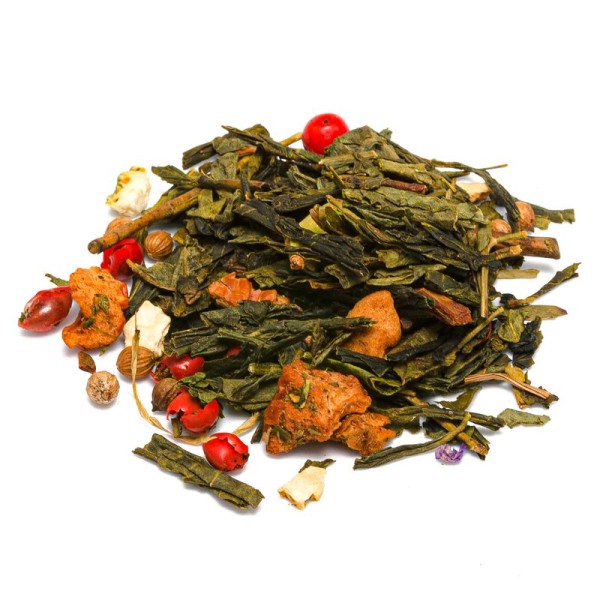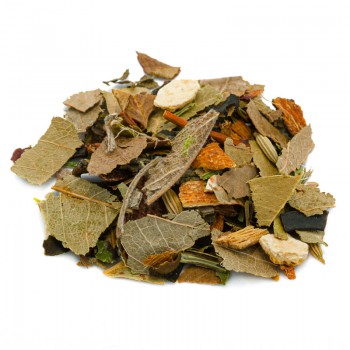To purify the body and maintain vitality, this green tea is particularly tasty. Its sweet flavor becomes fresh in the notes of orange.
It becomes enveloping thanks to ingredients such as vanilla, cloves, coriander and pink pepper. Not only is it tasty but the infusion also promises healthy virtues, such as green tea can give and some components strengthen.
Orange and vanilla green tea: properties and benefits
The addition of orange to green tea is useful for enhancing some draining and purifying properties. We know that green tea speeds up the metabolism and gives a detox effect on the body. It is ideal for those who want to lose weight, combining the diet with a herbal tea mid-morning or afternoon; or perhaps before going to sleep to avoid snacks that do not help the diet. Green tea speeds up your metabolism, regulates blood sugar, and helps your body burn fat. The antioxidant compounds of green tea can provide virtues that facilitate the correct metabolism of fat assimilation.
The addition of flavors such as orange and vanilla will help you enjoy this drink, while also bringing other beneficial characteristics. Green tea, especially in its green tea version, is one of the healthiest drinks ever. It is rich in antioxidants and various plant compounds that can benefit your health. Furthermore, an infusion of green tea, orange and vanilla helps reduce appetite, combining nutrients that give a sense of satiety and satisfy the palate with soft, sweet and satisfying flavours.
The orange peel, which makes this tea more aromatic, has been known to traditional Chinese medicine for centuries for its beneficial properties. It provides the body with vitamin C, effective for strengthening the immune system, and contains useful substances for correct digestion. The pectins contained in orange peel help regulate cholesterol levels. These substances combine with bile acids in the liver, which are not reabsorbed in the intestine but eliminated from the body through digestion.
A combination of green tea and orange peel also enhances the natural anti-inflammatory activity of these agents. Substances such as hesperidin and some antioxidant flavones counteract irritations in digestion, swelling, and help the growth of probiotic bacteria in the intestine (the immune system also benefits). Additionally, orange peel contains potassium, which helps regulate blood pressure; it is known as a useful ingredient in herbal teas to help against colds and for the well-being of the respiratory tract. The draining and purifying properties of this green tea herbal tea can also help after the after-effects of excess food and alcohol, to rebalance the body.
The vapors of this herbal tea envelop our senses also thanks to vanilla, pink pepper and cloves. Vanilla is also known for its antioxidant properties, through the vanillin agent, and promotes psycho-physical relaxation and well-being in digestion. Its exotic and intense aroma gives a note that can improve mood and stimulate the senses; for this reason, perhaps, vanilla was historically considered an aphrodisiac spice.
Origins and history of cultivation
The Sencha variety comes from the Camellia Sinensis plant, and differs in cultivation and processing from other types of tea, giving what we consider a green tea.
The leaves of the Sencha are grown in direct sunlight, and chosen from the first and second harvest, from among the younger and higher quality ones. In the historical preparation of Sencha green tea, the whole leaves are steamed for less than a minute, in order to avoid their oxidation. They are then rolled up and dried to be subsequently infused. The processing makes Sencha a golden and greenish green tea, with a sweet and refreshing aroma.
It is a tea that is now widespread in Japan, where it was introduced in the 15th century by visiting Chinese Buddhist monks. It has since been highly prized by samurai elites and feudal nobles, and has been part of the Japanese tea ceremony for centuries.
In addition to direct infusion, Sencha green tea is used as a base for herbal teas, for cooking and as an ingredient in cosmetic products. It has several benefits recognized in traditional medicine, including relaxing virtues on the mind and body. To date, several varieties of Sencha green tea are grown, organic or not,known for their different flavors and effects.
Among the main varieties, Shincha tea comes from the first harvest of sencha in spring – the freshest green tea leaves. Also known is the Kabusecha variety, a green tea grown in full shade for seven to ten days, which gives a slightly sweeter flavour. Finally, Gyokuro, similar to Kabusecha tea, which is covered in shade for twenty days. This process gives a sweeter tasting tea, and is the most expensive green tea in Japan.
To this basic ingredient, tea combines vanilla and orange peel, which have a different history as crops. The orange tree is a tree that we know has been cultivated for centuries for its fruit. It is one of the most cultivated plants in the world, also because it easily adapts to different environmental conditions. It appears to have originated as a hybrid between the pomelo and the mandarin, and has been known in China for over 4,000 years.
The vanilla, which gives one of the best known aromas in the world, is a species of orchid native to Mexico. Its pods give the characteristic fragrant notes, after having been subjected to a precise manufacturing process. The plant, known in its habitat by the indigenous people, was discovered by explorers; its name derives from the Spanish vania, i.e. pod, and illa which is the suffix for "small".
Vanilla was used by the native Aztecs to flavour xocoatl, the chocolate drink, and due to the aroma of its pods it was very successful when it was exported to Europe. It was in the Veracruz area that the first vanilla crops for industrial purposes originated. The pods are left to develop for around 9 months, then harvested and sent for processing, which uses different methods to obtain different aromatic nuances. Today it is used to flavor foods and drinks, chocolate, sweets and ice cream, as well as in perfumery.
Plant and flowers
Green tea comes from the Camellia Sinensis plant, native to East Asia. It represents a genus that includes approximately 250 species of evergreen trees and shrubs, belonging to the Theaceae family.
Camellia sinensis (also called Thea sinensis), is a plant that can reach 9 meters in height, but is generally grown in small size to a low bush, for ease of cultivation. The plant is pruned often to encourage the development of the tea leaves. The flowers are fragrant, yellow and about 4 cm wide.
The tree from which oranges are born is the Citrus sinensis belonging to the Rutaceae family. The orange tree produces sweet oranges as fruits, distinct from bitter oranges. The tree can reach up to 12 metres, features elongated leaves, white flowers known as orange blossoms, and round fruits with sweet pulp and orange skin. It adapts well to temperate climates, particularly in the southern Mediterranean.
The orange has great productivity, having a dormancy of only 3 months. For this reason, flowering can often be observed together with the orange harvest. The Vanilla planifolia is the most important of the 110 plant species of the Vanilla genus, which are part of the Orchidaceae family.
Vanilla plants display a climbing stem that attaches to trees, and roots that reach into the soil. The flowers, which vary from creamy white to pale green, are numerous, open in turns and last only one day. The flowering season lasts about two months, while the fruit, a long capsule, matures in 4-6 weeks but can take up to 9 months. The unripe pods are harvested when they turn gold at the base. We also know about Vanilla x-tahitensis, a Polynesian species with limited cultivation, and Vanilla pompona, cultivated in the West Indies. All species are thought to have derived from a single species native to Mexico, Central America, and northern South America.
Nutritional values of green, orange and vanilla tea
Green tea contains many polyphenol antioxidants, including the important EGCG (Epigallocatechin gallate). Additionally, it donates the chemicals methylxanthines (caffeine, theobromine, theophylline). It makes vitamin C, group B vitamins (thiamine, riboflavin, niacin) and minerals such as potassium, iron, magnesium, zinc available. The other key ingredient, orange peel, also contains potassium, vitamin C, vitamin A and B vitamins, iron, copper, phosphorus, selenium and magnesium. Other elements of this green tea strengthen the antioxidant content.
How to prepare orange, vanilla and green tea
Green tea with orange and vanilla is obtained by placing approximately 3-5 grams of the infusion preparation in a cup (250 ml), with water at 80 °C.
Leave it to infuse for 2 to 3 minutes before drinking the tea with its floral and exotic aroma. Add honey or sugar, if desired.
Orange and vanilla green tea: side effects and contraindications
Green tea can cause some side effects, especially if the recommended doses are not respected. The content of caffeine can cause discomfort. If consumed in excessive quantities, tea causes nervousness, anxiety, insomnia, rapid heartbeat.
Also, green tea could affect the functioning of the thyroid, or cause strain on the liver. For this reason, it is advisable to consult a specialist in case of related chronic pathologies. Caution is recommended regarding the ingredients of the tea, to be evaluated both for any allergies of which you are aware, and for pregnant and breastfeeding women.









 No reward points for this product.
No reward points for this product.








